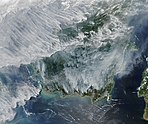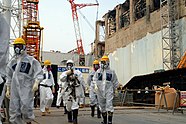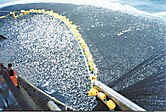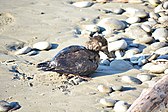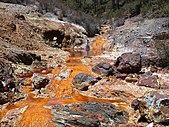 Global Information
Global InformationHuman impact on the environment information
- Top-left: Satellite image of Southeast Asian haze.
- Top-right: IAEA experts investigate the Fukushima disaster.
- Middle-left: a picture from 1997 of industrial fishing, a practice that has led to overfishing.
- Middle-right: a seabird during an oil spill.
- Bottom-left: Acid mine drainage in the Rio Tinto.
- Bottom-right: depiction of deforestation of Brazil's Atlantic forest by Portuguese settlers, c. 1820–25.
 |
| Environment |
|---|
|
|
|
|
| Part of a series on |
| Sociology |
|---|
 |
|
|
Human impact on the environment (or anthropogenic environmental impact) refers to changes to biophysical environments[1] and to ecosystems, biodiversity, and natural resources[2] caused directly or indirectly by humans. Modifying the environment to fit the needs of society (as in the built environment) is causing severe effects[3][4] including global warming,[1][5][6] environmental degradation[1] (such as ocean acidification[1][7]), mass extinction and biodiversity loss,[8][9][10] ecological crisis, and ecological collapse. Some human activities that cause damage (either directly or indirectly) to the environment on a global scale include population growth,[11][12][13] neoliberal economic policies[14][15][16] and rapid economic growth,[17] overconsumption, overexploitation, pollution, and deforestation. Some of the problems, including global warming and biodiversity loss, have been proposed as representing catastrophic risks to the survival of the human species.[18][19]
The term anthropogenic designates an effect or object resulting from human activity. The term was first used in the technical sense by Russian geologist Alexey Pavlov, and it was first used in English by British ecologist Arthur Tansley in reference to human influences on climax plant communities.[20] The atmospheric scientist Paul Crutzen introduced the term "Anthropocene" in the mid-1970s.[21] The term is sometimes used in the context of pollution produced from human activity since the start of the Agricultural Revolution but also applies broadly to all major human impacts on the environment.[22][23][24] Many of the actions taken by humans that contribute to a heated environment stem from the burning of fossil fuel from a variety of sources, such as: electricity, cars, planes, space heating, manufacturing, or the destruction of forests.[25]
- ^ a b c d Wuebbles DJ, Fahey DW, Hibbard KA, DeAngelo B, Doherty S, Hayhoe K, Horton R, Kossin JP, Taylor PC, Waple AM, Weaver CP (2017). "Executive Summary". In Wuebbles DJ, Fahey DW, Hibbard KA, Dokken DJ, Stewart BC, Maycock TK (eds.). Climate Science Special Report – Fourth National Climate Assessment (NCA4). Vol. I. Washington, DC: U.S. Global Change Research Program. pp. 12–34. doi:10.7930/J0DJ5CTG.
- ^ Sahney, Benton & Ferry (2010); Hawksworth & Bull (2008); Steffen et al. (2006) Chapin, Matson & Vitousek (2011)
- ^ Stockton, Nick (22 April 2015). "The Biggest Threat to the Earth? We Have Too Many Kids". Wired.com. Archived from the original on 18 December 2019. Retrieved 24 November 2017.
- ^ Ripple, William J.; Wolf, Christopher; Newsome, Thomas M.; Barnard, Phoebe; Moomaw, William R. (5 November 2019). "World Scientists' Warning of a Climate Emergency". BioScience. doi:10.1093/biosci/biz088. hdl:1808/30278. Archived from the original on 3 January 2020. Retrieved 8 November 2019.
Still increasing by roughly 80 million people per year, or more than 200,000 per day (figure 1a–b), the world population must be stabilized—and, ideally, gradually reduced—within a framework that ensures social integrity. There are proven and effective policies that strengthen human rights while lowering fertility rates and lessening the impacts of population growth on GHG emissions and biodiversity loss. These policies make family-planning services available to all people, remove barriers to their access and achieve full gender equity, including primary and secondary education as a global norm for all, especially girls and young women (Bongaarts and O'Neill 2018).
- ^ Cook, John (13 April 2016). "Consensus on consensus: a synthesis of consensus estimates on human-caused global warming". Environmental Research Letters. 11 (4): 048002. Bibcode:2016ERL....11d8002C. doi:10.1088/1748-9326/11/4/048002. hdl:1983/34949783-dac1-4ce7-ad95-5dc0798930a6.
The consensus that humans are causing recent global warming is shared by 90%–100% of publishing climate scientists according to six independent studies
- ^ Lenton, Timothy M.; Xu, Chi; Abrams, Jesse F.; Ghadiali, Ashish; Loriani, Sina; Sakschewski, Boris; Zimm, Caroline; Ebi, Kristie L.; Dunn, Robert R.; Svenning, Jens-Christian; Scheffer, Marten (2023). "Quantifying the human cost of global warming". Nature Sustainability. 6 (10): 1237–1247. Bibcode:2023NatSu...6.1237L. doi:10.1038/s41893-023-01132-6. hdl:10871/132650.
- ^ "Increased Ocean Acidity". Epa.gov. United States Environmental Protection Agency. 30 August 2016. Archived from the original on 23 June 2011. Retrieved 23 November 2017.
Carbon dioxide is added to the atmosphere whenever people burn fossil fuels. Oceans play an important role in keeping the Earth's carbon cycle in balance. As the amount of carbon dioxide in the atmosphere rises, the oceans absorb a lot of it. In the ocean, carbon dioxide reacts with seawater to form carbonic acid. This causes the acidity of seawater to increase.
- ^ Leakey, Richard and Roger Lewin, 1996, The Sixth Extinction : Patterns of Life and the Future of Humankind, Anchor, ISBN 0-385-46809-1
- ^ Ceballos, Gerardo; Ehrlich, Paul R.; Barnosky, Anthony D.; Garcia, Andrés; Pringle, Robert M.; Palmer, Todd M. (2015). "Accelerated modern human–induced species losses: Entering the sixth mass extinction". Science Advances. 1 (5): e1400253. Bibcode:2015SciA....1E0253C. doi:10.1126/sciadv.1400253. PMC 4640606. PMID 26601195.
- ^ Pimm, S. L.; Jenkins, C. N.; Abell, R.; Brooks, T. M.; Gittleman, J. L.; Joppa, L. N.; Raven, P. H.; Roberts, C. M.; Sexton, J. O. (30 May 2014). "The biodiversity of species and their rates of extinction, distribution, and protection" (PDF). Science. 344 (6187): 1246752. doi:10.1126/science.1246752. PMID 24876501. S2CID 206552746. Archived (PDF) from the original on 7 January 2020. Retrieved 15 December 2016.
The overarching driver of species extinction is human population growth and increasing per capita consumption.
- ^ Crist, Eileen; Ripple, William J.; Ehrlich, Paul R.; Rees, William E.; Wolf, Christopher (2022). "Scientists' warning on population" (PDF). Science of the Total Environment. 845: 157166. Bibcode:2022ScTEn.845o7166C. doi:10.1016/j.scitotenv.2022.157166. PMID 35803428. S2CID 250387801.
- ^ Perkins, Sid (11 July 2017). "The best way to reduce your carbon footprint is one the government isn't telling you about". Science. Archived from the original on 1 December 2017. Retrieved 29 November 2017.
- ^ Nordström, Jonas; Shogren, Jason F.; Thunström, Linda (15 April 2020). "Do parents counter-balance the carbon emissions of their children?". PLOS One. 15 (4): e0231105. Bibcode:2020PLoSO..1531105N. doi:10.1371/journal.pone.0231105. PMC 7159189. PMID 32294098.
It is well understood that adding to the population increases CO2 emissions.
- ^ Harvey, David (2005). A Brief History of Neoliberalism. Oxford University Press. p. 173. ISBN 978-0199283279.
- ^ Rees, William E. (2020). "Ecological economics for humanity's plague phase" (PDF). Ecological Economics. 169: 106519. Bibcode:2020EcoEc.16906519R. doi:10.1016/j.ecolecon.2019.106519. S2CID 209502532.
the neoliberal paradigm contributes significantly to planetary unraveling. Neoliberal thinking treats the economy and the ecosphere as separate independent systems and essentially ignores the latter.
- ^ Jones, Ellie-Anne; Stafford, Rick (2021). "Neoliberalism and the Environment: Are We Aware of Appropriate Action to Save the Planet and Do We Think We Are Doing Enough?". Earth. 2 (2): 331–339. Bibcode:2021Earth...2..331J. doi:10.3390/earth2020019.
- ^ Cafaro, Philip (2022). "Reducing Human Numbers and the Size of our Economies is Necessary to Avoid a Mass Extinction and Share Earth Justly with Other Species". Philosophia. 50 (5): 2263–2282. doi:10.1007/s11406-022-00497-w. S2CID 247433264.
Conservation biologists agree that humanity is on the verge of causing a mass extinction and that its primary driver is our immense and rapidly expanding global economy.
- ^ "New Climate Risk Classification Created to Account for Potential "Existential" Threats". Scripps Institution of Oceanography. 14 September 2017. Archived from the original on 15 September 2017. Retrieved 24 November 2017.
A new study evaluating models of future climate scenarios has led to the creation of the new risk categories "catastrophic" and "unknown" to characterize the range of threats posed by rapid global warming. Researchers propose that unknown risks imply existential threats to the survival of humanity.
- ^ Torres, Phil (11 April 2016). "Biodiversity loss: An existential risk comparable to climate change". Thebulletin.org. Taylor & Francis. Archived from the original on 13 April 2016. Retrieved 24 November 2017.
- ^ Bampton, M. (1999) "Anthropogenic Transformation" Archived 22 September 2020 at the Wayback Machine in Encyclopedia of Environmental Science, D. E. Alexander and R. W. Fairbridge (eds.), Kluwer Academic Publishers, Dordrecht, The Netherlands, ISBN 0412740508.
- ^ Crutzen, Paul and Eugene F. Stoermer. "The 'Anthropocene'" in International Geosphere-Biosphere Programme Newsletter. 41 (May 2000): 17–18
- ^ Scott, Michon (2014). "Glossary". NASA Earth Observatory. Archived from the original on 17 September 2008. Retrieved 3 November 2008.
- ^ Syvitski, Jaia; Waters, Colin N.; Day, John; et al. (2020). "Extraordinary human energy consumption and resultant geological impacts beginning around 1950 CE initiated the proposed Anthropocene Epoch". Communications Earth & Environment. 1 (32): 32. Bibcode:2020ComEE...1...32S. doi:10.1038/s43247-020-00029-y. hdl:10810/51932. S2CID 222415797.
- ^ Cite error: The named reference
Elhacham2020was invoked but never defined (see the help page). - ^ Trenberth, Kevin E. (2 October 2018). "Climate change caused by human activities is happening and it already has major consequences". Journal of Energy & Natural Resources Law. 36 (4): 463–481. Bibcode:2018JENRL..36..463T. doi:10.1080/02646811.2018.1450895. ISSN 0264-6811. S2CID 135104338.
